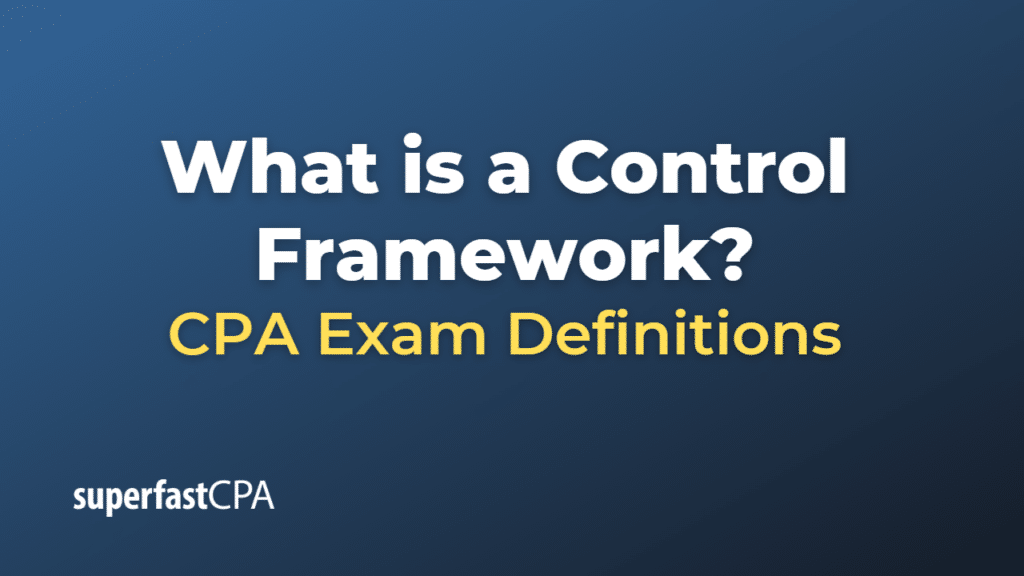Control Framework
A control framework is a structured set of guidelines, principles, and methodologies used by organizations to design, implement, and maintain an effective internal control system. A control framework provides a systematic approach to managing risks, ensuring the reliability of financial reporting, and promoting compliance with applicable laws and regulations. By adopting a control framework, organizations can enhance their overall governance, risk management, and internal control processes.
There are several well-known control frameworks that organizations can use as a basis for their internal control systems, including:
- COSO Internal Control – Integrated Framework: Developed by the Committee of Sponsoring Organizations of the Treadway Commission (COSO), this framework is widely recognized and used by organizations around the world. It consists of five interrelated components: control environment, risk assessment, control activities, information and communication, and monitoring activities.
- COBIT (Control Objectives for Information and Related Technologies): Developed by the Information Systems Audit and Control Association (ISACA), COBIT is a comprehensive framework that focuses on the governance and management of information technology (IT) within an organization. It provides a set of best practices, tools, and models to help organizations achieve their IT-related objectives and manage IT-related risks.
- ISO 31000: This is an international standard for risk management, developed by the International Organization for Standardization (ISO). It provides a set of principles, a risk management framework, and a risk management process that organizations can use to identify, assess, and manage risks effectively.
- Sarbanes-Oxley Act (SOX) Section 404: For public companies in the United States, the Sarbanes-Oxley Act requires management to establish and maintain an adequate internal control structure and procedures for financial reporting. While not a control framework itself, SOX has led many organizations to adopt one of the aforementioned frameworks, like COSO or COBIT, to comply with the requirements of the law.
Organizations may choose to adopt one of these frameworks or develop their own, tailored to their specific needs and objectives. The key is to ensure that the control framework provides a structured and systematic approach to managing risks, ensuring the reliability of financial reporting, and promoting compliance with applicable laws and regulations.
Example of a Control Framework
Let’s consider a hypothetical example of a medium-sized software development company that decides to implement the COSO Internal Control – Integrated Framework to strengthen its internal control system.
- Control Environment: The company’s management team establishes a culture of integrity and ethical behavior by setting a clear code of conduct and demonstrating commitment to strong governance. They provide training on the importance of internal controls and establish a well-defined organizational structure with clear lines of authority and reporting relationships.
- Risk Assessment: The company identifies potential risks to achieving its objectives, such as financial reporting errors, non-compliance with regulations, and operational inefficiencies. The management team then prioritizes these risks based on their likelihood and potential impact on the organization.
- Control Activities: To mitigate the identified risks, the company designs and implements control activities, such as segregation of duties, authorization and approval procedures, and IT security controls. These control activities help ensure that the company’s objectives are met and that potential errors or fraud are detected and prevented.
- Information and Communication: The company establishes effective communication channels, both internally and externally, to ensure that relevant information is shared in a timely manner. Employees are encouraged to report concerns or potential issues related to internal controls, ethics, or compliance through established reporting mechanisms.
- Monitoring Activities: The company regularly monitors the performance and effectiveness of its internal control system, using tools such as internal audits, management reviews, and key performance indicators (KPIs). Any identified weaknesses or deficiencies are addressed through corrective actions and continuous improvement efforts.
In this example, the software development company adopts the COSO Internal Control – Integrated Framework to enhance its governance, risk management, and internal control processes. By implementing this control framework, the company can better manage risks, ensure the reliability of financial reporting, and promote compliance with applicable laws and regulations.













